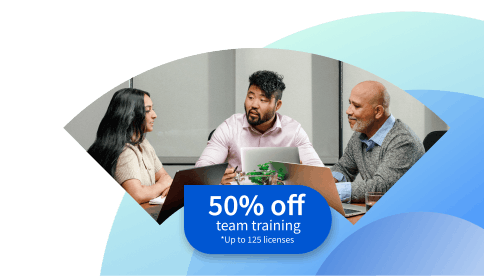What Is Adaptive Learning?
Discover a learning approach that adapts to you, helping you focus on what matters most and move forward with confidence.
![[Featured Image] A professional sits at a laptop in their home office using an adaptive learning program and writes notes on paper.](https://d3njjcbhbojbot.cloudfront.net/api/utilities/v1/imageproxy/https://images.ctfassets.net/wp1lcwdav1p1/7fLyhI9B6jEQ8GYvYYcNdN/d2fcf7db21f068b477bcd8070fc1025b/GettyImages-2229142471.jpg?w=1500&h=680&q=60&fit=fill&f=faces&fm=jpg&fl=progressive&auto=format%2Ccompress&dpr=1&w=1000)
Key takeaways
Adaptive learning is an educational approach that uses artificial intelligence (AI) and data analytics to adjust lessons and assessments to each learner.
A recent scoping review found that adaptive learning increased academic performance in 59 percent of studies [1].
Adaptive learning algorithms respond to your input in real time, creating a personalized learning pathway tailored to your needs.
You can improve the effectiveness of your online learning by engaging with lessons that adapt to your current skill level.
Explore what adaptive learning is and how it can shape your educational pathway by focusing on exactly what matters for your growth. If you’re ready to start learning right away, Specializations like the AI Foundations for Everyone Specialization demonstrate how AI algorithms create adaptive approaches that personalize complex topics, helping you learn at your own pace.
Types of adaptive learning technology
Adaptive learning technology can take various forms, each designed to personalize the learning experience in a distinct way. In many cases, platforms will use several types of adaptive learning technology simultaneously, integrating resources to provide more meaningful support.
When exploring types of adaptive learning technology, you’ll likely come across three main areas:
Adaptive content
Adaptive content provides you with materials, such as videos, readings, or exercises, selected to match your skill level or knowledge gaps. For example, if you were taking a math course with adaptive content, you might start with a wide range of basic math questions. If you answered all geometry questions correctly and all algebra questions incorrectly, an adaptive content algorithm might provide extra practice problems centered on algebraic concepts.
As you answered each algebraic question, the algorithm would pinpoint which concepts you were more likely to answer correctly or incorrectly, narrowing your practice problems to target the areas where you could benefit from extra repetition.
Adaptive sequence
Another way to adapt your learning is through an adaptive sequence. With adaptive sequence technology, not only is your content personalized, but the order in which you view the content is also adjusted to best suit your learning style.
For example, going back to the previous math example, consider that you are completing algebra problems, and the algorithm notices you tend to answer questions involving graphs incorrectly. Even if the traditional sequence of materials does not include a graphing section, the algorithm may pull relevant material to create a section that can help you build necessary skills before moving to more challenging topics.
Adaptive assessments
With adaptive assessments, the goal is to determine precisely where you are in your learning process. Instead of giving all learners the same set of questions, the algorithm will tailor each subsequent assessment question based on your answer to the previous one. These questions become more or less challenging depending on how you answer them. At the end of the assessment, you’ll be able to see what material you’ve mastered and what material you may want to give extra attention to.
With adaptive assessments, you may see both question-level adaptive testing and multistage adaptive design. For question-level adaptive testing, your questions are tailored based on whether you answered the previous one correctly or incorrectly. With multistage adaptive testing, you receive a set of questions, and then each subsequent set depends on your performance on the previous batch of questions. As more assessments move online, even traditional tests like the SAT and PSAT are beginning to use adaptive assessments to gauge learner performance more accurately.
What is an adaptive learning platform?
An adaptive learning platform is the software system that brings adaptive learning technologies together. Within an adaptive learning platform, you’ll typically find several features that help you navigate and track your learning experience. Ones to note include:
Interactive dashboards and progress tracking
You can monitor your progress through visualizations that display metrics such as completed activities, performance, and learning status, either individually or in relation to a group. Instructors can use these dashboards to identify learners who may require additional support and tailor their instruction to meet the needs of the group.
Personalized recommendations
Adaptive learning platforms typically offer several layers of personalization. For starters, you may see content displayed in your preferred format, resources chosen based on your performance, and a recommended learning trajectory to your end goals based on the concepts that need more or less time.
Read more: Transforming Corporate Training with Personalized Learning
What is an example of an adaptive learning platform?
Duolingo, a popular language-learning app, is one example of an adaptive learning platform. As you progress through exercises, the app tracks your performance and adjusts the difficulty of your questions based on whether you answer simpler ones correctly.
If you complete skills practice and master a particular skill, the app will also integrate this knowledge into more general practice, helping to personalize your learning pathway. Conversely, if you want to focus on areas that are more challenging for you, you can utilize an adaptive “mistakes practice” feature, which gives repetition to concepts or ideas that have repeatedly been more difficult in your practice sessions.

How does adaptive learning work?
Adaptive learning works by collecting data on how you interact with content and then adjusting instruction in real time. This relies on core technical systems rooted in machine learning and data science algorithms. Typically, an algorithm might follow a sequence such as:
Data collection: The platform records your responses to questions or interactions with materials.
Modeling: The machine learning models analyze patterns to identify knowledge gaps and predict future areas of strength or weakness in your learning.
Personalized recommendations: Based on these predictions, the system adjusts the sequence or difficulty of content it delivers.
Continuous feedback: The model continually refines its predictions and recommendations as you take new learning actions.
How can AI contribute to adaptive learning platforms?
You can find AI contributions to adaptive learning in action across various industries and in education. At a learner level, AI drives personalization. For example, at Arizona State University, the math department uses a Mathematics Placement Assessment with the adaptive platform ALEKS to evaluate each incoming student’s current knowledge and match them with the right course [2, 3].
At a higher level, AI can analyze large volumes of data on adaptive learning platforms to identify learner trends and correlations. This can showcase the most effective teaching strategies, inform the development of evidence-based practices in education, and help educational researchers uncover insights more effectively.
Adaptations for learning: How to adapt to different learning styles
One of the strengths of adaptive learning is its ability to recognize that not all learners absorb information the same way. Adaptive platforms can tailor instruction to meet a variety of preferences, such as:
Visual learning: Learners benefit from diagrams, videos, and infographics.
Auditory learning: Learners benefit from narrated lectures, podcasts, or text-to-speech options.
Kinesthetic learning: Learners benefit from interactive tasks and simulations.
Learning adaptations can also focus on accessibility for learners with disabilities, such as those with dyslexia or neurodiverse learning styles. Incorporating adaptive learning into education not only helps personalize education but also ensures inclusivity, allowing every learner to engage with material in ways that maximize understanding and success.
What is an example of adaptive teaching?
An example of adaptive teaching is when an AI-powered platform analyzes your responses during a lesson and instantly adjusts the material. For example, an AI platform might notice you learn better through visuals and begin presenting concepts with more diagrams and interactive charts, rather than text-heavy explanations. Or the algorithm may notice you miss a particular concept and provide more repetition in that area. The teaching adapts to you by aligning the format with your learning style.

Pros and cons of adaptive learning technology
As with any educational technology, adaptive learning presents both benefits and challenges to consider when selecting the right resources for your needs.
Advantages you might find when using adaptive learning technology include immediate feedback, which allows you to identify and correct mistakes quickly. You may also benefit from personalization, tailoring lessons to your pace, knowledge gaps, and strengths. In this same vein, adaptive learning typically provides supplemental support, offering you additional resources when needed and promoting inclusivity through accommodating diverse learning preferences.
On the other side, challenges to consider typically stem from concerns with the privacy and security of AI, alongside challenges in controlling potential bias within algorithm training on incomplete or skewed data. In addition, while technology can enhance learning efficiency, it typically results in less human interaction, which can reduce the benefits of mentoring and collaboration. However, by being aware of the challenges and addressing them through safeguards such as data protection and blended learning models, you can leverage the benefits of adaptive learning while minimizing the associated risks.
Getting started with adaptive learning
As a learner, you can start exploring adaptive learning by trying out platforms that already integrate these technologies. For language learning, Duolingo adjusts lessons based on your performance. Platforms like Adaptemy, Pearson MyLab & Mastering, and Smart Sparrow focus on academic subjects, such as math and science, and adjust lesson sequences in real time to match your progress.
If you’d like to implement adaptive learning in your workplace, you can start by discussing your ideas with leadership and relevant stakeholders. Updating existing platforms and processes can be time-consuming, and you may want to start with a smaller pilot program involving one course or type of training. Over time, you can refine content, ensure safeguards for privacy and security, and gradually scale to more learning trajectories.
Explore our free resources for successful learning
If you’re interested in how you can maximize your learning and boost your skill set, check out the Coursera YouTube channel to explore skill-building advice, career pathways, and how to take the next step to reach your goals. To start, consider:
Watch on YouTube: The Career Advancement Episode Everyone Needs to Hear
Get insider advice: Your top skills and courses, 100 issues later!
Get AI tips: ‘A Game Changer’: How a Product Analyst Strengthened His Learning with the AI Tool Coursera Coach
If you want to start learning new skills today, a subscription to Coursera Plus allows you to access more than 10,000 programs by over 350 leading companies and universities. You can earn your credentials at your own pace and build skills directly related to your interest areas.
Article sources
ScienceDirect. “Personalized adaptive learning in higher education: A scoping review of key characteristics and impact on academic performance and engagement, https://www.sciencedirect.com/science/article/pii/S2405844024156617.” Accessed November 25, 2025.
Arizona State University. “What is ALEKS?, https://www.sciencedirect.com/science/article/pii/S2405844024156617.” Accessed November 25, 2025.
Arizona State University. “Math Courses, https://www.sciencedirect.com/science/article/pii/S2405844024156617.” Accessed November 25, 2025.
Coursera Staff
Editorial Team
Coursera’s editorial team is comprised of highly experienced professional editors, writers, and fact...
This content has been made available for informational purposes only. Learners are advised to conduct additional research to ensure that courses and other credentials pursued meet their personal, professional, and financial goals.



